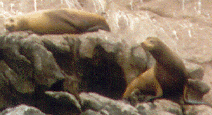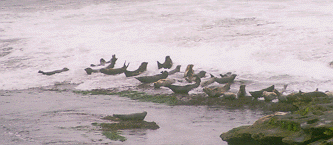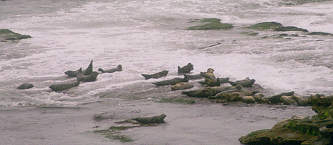
Why do harbor seals haul out on Children's Pool Beach?
There are actually a number of questions embedded in that one:
- Why do seals haul out, anywhere?
- Water conducts heat easily, so aquatic mammals are faced with the
problem of staying warm. There are several approaches possible: grow
extremely thick insulation (like blubber in whales), grow huge bodies (which
decreases the surface:volume ratio, slowing heat loss; whales), eat a
lot of food to burn for metabolic heat (for example, harbor
porpoises), or get out of the water to rest (seals, sea otters). Of course, many
used combinations of these approaches; seals both haul out and have
insulating fur and fat. For the species that haul out, time spent on land is
time not losing heat so rapidly, and so not having to eat so much. It is a vital
aspect of their overall energy balance strategy.
- Why would seals haul out on beaches (instead of rocks)?
- They use both. They probably do not care about the softness of
sand, so their decisions are (presumably) based on other factors: temperature
(since they are well-insulated, warm sand can be too warm), safety
(can predators attack them?), and shelter (protection from heavy surf).
Offshore islands, sandbars, and rocky coasts tend to be hardest for land-based
predators to reach. If coastal beaches were safe (no bears, wolves, coyotes,
mountain lions or humans waiting to attack), it is likely that seals would use
sheltered beaches more often.
 It is important to distinguish seals
from sea lions here. Sea lions can hold their front flippers under their bodies
and swivel their hind flippers around also (see photo). As a result, they can
climb rocks (as well as stairs, as they often do in captivity) fairly easily. Seals
cannot support themselves on their flippers and for them moving on land is a
slow, laborious process.
It is important to distinguish seals
from sea lions here. Sea lions can hold their front flippers under their bodies
and swivel their hind flippers around also (see photo). As a result, they can
climb rocks (as well as stairs, as they often do in captivity) fairly easily. Seals
cannot support themselves on their flippers and for them moving on land is a
slow, laborious process.
- Why might they prefer Children's Pool Beach instead of Seal Rock?
-
|
If a picture is worth a thousand words; here's an essay on the answer:
In the first of these two photos, the rising
tide has sent a wave into the line of seals on the low rocks just south of Seal
Rock. Note the position of the seals on the left side. |  |
| And look where they are now. The
problem with intertidal rocks is that as the tide rises, seals get swept off; as
the tide falls, it becomes potentially a long drop for a not-very-nimble seal to
face if a predator (or well-intentioned but intrusive human) appears.
|  |
How would you scramble up and down this rock at low tide if you
were a seal?

- Last, given reasons to prefer the beach, why here? why now?
- Intuitively, the seals' recent adoption of the beach as a haulout seems likely to be related to creation of the Seal Rock Marine Reserve in 1994. However, the Marine Mammal Protection Act of 1972 protects seals from harassment wherever they are in US waters, and La Jolla's harbor seals are virtually unique in their use of a beach frequented by people. There is no other place on the west coast of North America where it is possible to approach wild harbor seals so closely, so easily. So the answer to this aspect of the question is, We don't really know!
Back to home
page


 It is important to distinguish seals
from sea lions here. Sea lions can hold their front flippers under their bodies
and swivel their hind flippers around also (see photo). As a result, they can
climb rocks (as well as stairs, as they often do in captivity) fairly easily. Seals
cannot support themselves on their flippers and for them moving on land is a
slow, laborious process.
It is important to distinguish seals
from sea lions here. Sea lions can hold their front flippers under their bodies
and swivel their hind flippers around also (see photo). As a result, they can
climb rocks (as well as stairs, as they often do in captivity) fairly easily. Seals
cannot support themselves on their flippers and for them moving on land is a
slow, laborious process.


